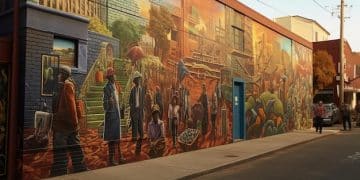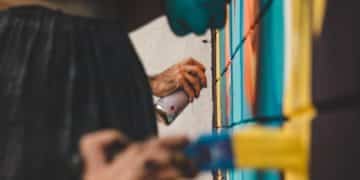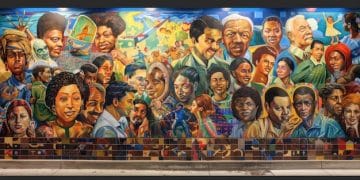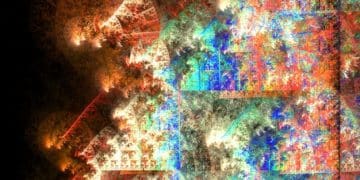Best Practices for Large-Scale Graffiti Murals in US 2025
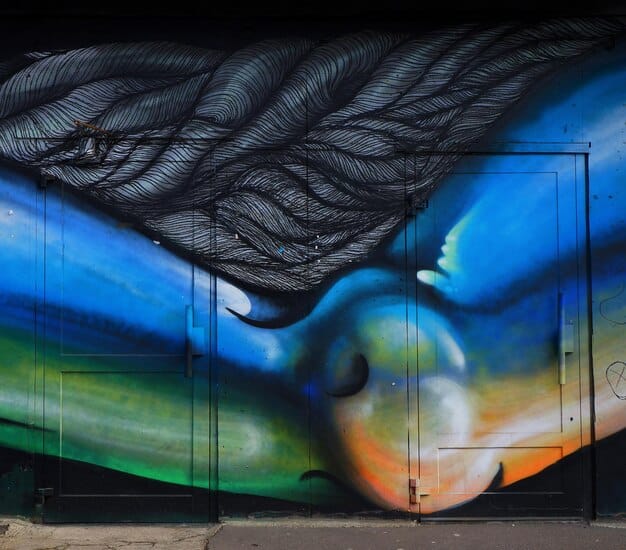
Navigating the intricate landscape of large-scale graffiti art murals in the US by 2025 demands a blend of artistic vision, meticulous planning, and adherence to evolving legal and community engagement frameworks to ensure impactful and sustainable public art.
Creating large-scale graffiti art murals in the US by 2025 involves a nuanced intersection of artistic expression, urban development, and community engagement. Understanding the evolving landscape of regulations, techniques, and collaborative practices is crucial for artists aiming to produce impactful, legal, and sustainable public artworks.
The Evolving Landscape of Graffiti Art Murals in the US
The perception and acceptance of graffiti art have undergone a significant transformation, moving from mere vandalism to a recognized form of public art. In the US, cities are increasingly embracing murals as tools for urban revitalization, cultural expression, and community building. This evolution brings new opportunities, but also increased scrutiny and the need for more structured approaches to creation and execution.
Shifting Perceptions and Legal Frameworks
The journey of graffiti from underground expression to mainstream acceptance is marked by changing legal frameworks. What was once universally outlawed is now, in many municipalities, regulated and even celebrated. Artists must navigate a complex web of city ordinances, permitting processes, and property owner agreements. Engaging with local art councils and urban planning departments is essential to understand specific requirements, which can vary wildly from one city to the next.
- Research local ordinances and permitting processes thoroughly.
- Identify property owners and secure explicit, written permission.
- Understand zoning laws and historical district restrictions.
This shift signifies a maturation of the art form, demanding professionalism and a commitment to legal compliance. Without proper authorization, even the most stunning mural risks swift removal and legal repercussions. The movement towards formal recognition necessitates artists becoming adept at bureaucratic navigation as much as artistic execution.
Technological Advancements and Their Impact
Modern technology significantly influences how large-scale murals are planned, designed, and executed. Digital tools allow artists to create detailed mock-ups, project designs onto large surfaces with precision, and even simulate the final look before a single can of paint is sprayed. Drones are increasingly used for site surveys, capturing high-resolution images of potential walls, assessing surface conditions, and even assisting in the initial grid layout for massive designs. These advancements streamline the process, reduce errors, and allow for greater artistic ambition and complexity. The integration of digital design software, such as Adobe Photoshop or Illustrator, enables detailed pre-visualization, helping artists and clients communicate and refine a concept efficiently before any physical work begins. This pre-planning minimizes costly mistakes and ensures the final product aligns perfectly with the shared vision, making the execution phase smoother and more predictable.
Planning and Design: From Concept to Canvas
The success of any large-scale mural hinges on meticulous planning and innovative design. This phase is where artistic vision meets practical constraints, demanding a blend of creativity, foresight, and logistical acumen. A well-executed preliminary stage significantly reduces challenges during the painting process and ensures the final mural achieves its intended impact.
Conceptualization and Client Collaboration
Every great mural begins with a compelling concept. For commissioned works, this involves close collaboration with the client or community group. Understanding their vision, desired message, and the context of the wall’s location is paramount. Iterative design processes, where sketches and digital renderings are shared and refined, help bridge the gap between artistic ideas and client expectations. This collaborative approach ensures that the final artwork resonates with its intended audience and fulfills its purpose, whether it’s beautification, storytelling, or social commentary.
The conceptual phase also involves considering the mural’s longevity and maintenance. Artists should discuss material choices, protective coatings, and potential future maintenance plans with clients. A clear understanding of the project’s scope, budget, and timeline is critical to avoid misunderstandings and ensure a smooth execution. Establishing a clear communication channel from the outset fosters trust and facilitates problem-solving throughout the project lifecycle.
Site Assessment and Preparation
Before any paint touches the wall, a thorough site assessment is non-negotiable. This includes analyzing the wall’s material, its structural integrity, sun exposure, and proximity to foot traffic or vehicles. Surface preparation is equally vital; cleaning, repairing cracks, and priming the wall create a stable foundation for the artwork, enhancing its durability and vibrancy. Ignoring these steps can lead to premature fading, cracking, or even the eventual deterioration of the mural. Proper preparation extends the life of the artwork, ensuring it remains impactful for years to come.
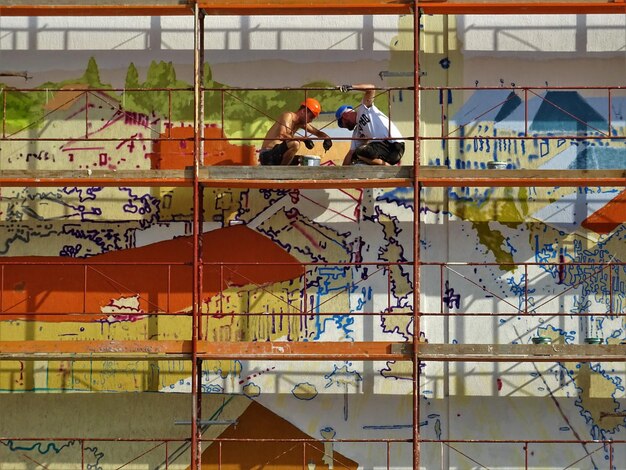
Considering the environmental impact is also becoming increasingly important. Artists are exploring eco-friendly paints and materials, and considering the surrounding flora and fauna during the planning stages. This responsible approach aligns with growing societal values and contributes to a more sustainable art practice, further solidifying the mural’s positive presence within the community. Adequate ventilation and personal protective equipment are also critical safety considerations during the preparation and painting phases, particularly when working with certain chemicals or in enclosed spaces.
Execution Techniques and Advanced Materials
The actual painting of a large-scale mural is a physically demanding and technically intricate process. Employing the right techniques and utilizing advanced materials are crucial for achieving professional results, ensuring longevity, and maximizing the visual impact of the artwork. The scale of these projects often necessitates specialized tools and a systematic approach.
Utilizing Scaffolding and Lifts Safely
Working on large walls often requires access to significant heights. Scaffolding, boom lifts, and scissor lifts are indispensable tools, but their use demands strict adherence to safety protocols. Artists must be trained in their operation and certified when necessary. Proper harnessing, stable setups, and awareness of surroundings are non-negotiable to prevent accidents and ensure a safe working environment for all involved. Safety should always be prioritized over speed or convenience.
Beyond safety, the strategic placement and movement of access equipment can significantly impact the efficiency of the artwork’s application. Planning the sequence of painting based on accessibility
minimizes repositioning delays. Effective communication among team members operating these machines is also paramount to ensure smooth and coordinated movements, preventing collisions or misalignments that could damage the artwork or equipment. Regular maintenance checks on all machinery are also essential to ensure their reliable and safe operation throughout the project duration.
Advanced Paint and Protective Coatings
The choice of paint gravely affects a mural’s durability, vibrancy, and resistance to environmental factors. Artists are increasingly opting for high-quality, exterior-grade acrylic or latex paints, known for their colorfastness and weather resistance. Furthermore, the application of anti-graffiti and UV-resistant protective coatings is becoming standard practice. These coatings shield the mural from further vandalism, make cleaning easier, and prevent fading from sun exposure, significantly extending the artwork’s lifespan.
- Choose paints specifically formulated for exterior use.
- Apply UV-resistant clear coats to prevent fading.
- Consider anti-graffiti coatings for added protection.
The development of innovative paint technologies, such as paints that absorb pollutants or reflective paints that help cool urban environments, offers new possibilities for murals to serve functional purposes beyond aesthetic appeal. Researching and experimenting with these cutting-edge materials can distinguish an artist’s work and contribute positively to urban ecology. Staying informed about new products entering the market ensures artists can leverage the latest advancements for superior results and longevity.
Community Engagement and Ethical Considerations
Large-scale murals often become focal points within communities, making community engagement a critical component of the creation process. Ethical considerations, ranging from cultural appropriation to environmental impact, also play a significant role in ensuring the artwork is well-received and contributes positively to the urban fabric. Respect for local values and perspectives is paramount.
Involving the Community in the Process
For public art to truly resonate, it often needs to involve the community it serves. This can range from soliciting ideas during the conceptual phase to organizing community paint days where residents, particularly youth, can contribute to parts of the mural under supervision. Such engagement fosters a sense of ownership and pride, transforming the mural from merely an artwork into a shared heritage. Workshops and public presentations about the project can also build enthusiasm and understanding, ensuring the mural is a welcome addition.
Engaging local businesses and organizations can also generate support and resources for major projects. Collaborating with schools for educational initiatives centered around the mural enhances its community impact, embedding the artwork within the educational and social framework of the area. These grassroots efforts ensure the mural reflects the spirit and aspirations of the people it represents, ensuring it’s not just seen but truly embraced.
Navigating Cultural Sensitivity and Messaging
Murals, by their very public nature, carry significant social responsibility. Artists must be acutely aware of cultural sensitivities, historical contexts, and community values when designing their work. What might be acceptable in one neighborhood could be offensive in another. Researching the demographic and historical background of the area, and even consulting local historians or community leaders, can prevent misinterpretations and ensure the mural’s message is both positive and appropriate. Avoiding clichés or stereotypical representations is also vital to creating authentic and meaningful art.
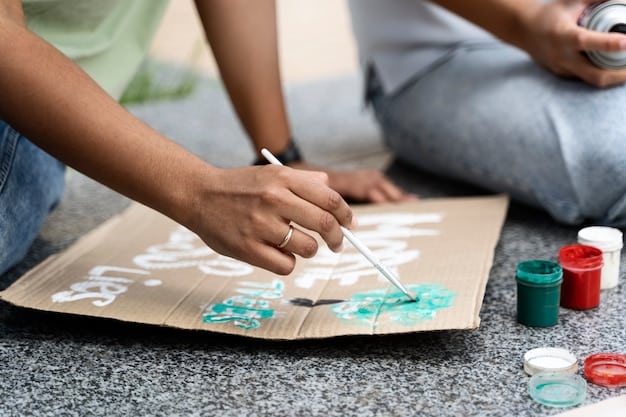
Open dialogue and feedback mechanisms throughout the design process are invaluable. Addressing concerns early on demonstrates respect and a commitment to inclusivity, fostering goodwill and ensuring the mural is a source of unity rather than division. The goal is to create art that speaks to and elevates the human spirit, contributing positively to the collective narrative of the space it occupies. The artist’s intention must align with the community’s interpretation to truly succeed. This ongoing dialogue can lead to more nuanced and universally appreciated designs.
Maintenance, Longevity, and Legacy
The creation of a large-scale mural is not merely about its completion; it’s about ensuring its longevity and establishing a lasting legacy. Proper maintenance, strategic planning for future preservation, and documentation are crucial for the artwork to endure and continue to inspire for decades. These often-overlooked aspects are as vital as the initial artistic execution.
Strategies for Preservation and Repair
Despite advanced materials, murals are exposed to the elements and potential vandalism. Regular maintenance checks, including cleaning and minor repairs, are essential for preserving their integrity. Having a contingency plan for significant damage, such as a pre-mixed patch of colors or digital copies of the original design, can facilitate quicker and more accurate restoration. Establishing a maintenance schedule and allocating resources for it from the project’s inception can prevent larger, more costly repairs down the line.
- Implement a routine cleaning schedule.
- Keep records of paint colors and material specifications.
- Plan for periodic touch-ups and potential restoration.
Developing relationships with local conservation experts or organizations specializing in outdoor art preservation can provide invaluable guidance and support for major restoration efforts. These experts can offer insights into the long-term effects of environmental factors and recommend advanced preservation techniques. Community involvement in preservation efforts can also foster a sense of shared responsibility and ensure continued care for the artwork.
Documenting the Artwork for Future Generations
Beyond its physical presence, documenting the mural’s creation process and its finished state is vital for its historical record and educational value. High-resolution photographs, time-lapse videos of the painting process, and interviews with the artists and community members involved create a comprehensive archive. This documentation not only celebrates the artwork but also serves as a valuable resource for art historians, urban planners, and future artists, contributing to the broader narrative of public art.
Creating digital archives accessible to the public, perhaps through online galleries or city art portals, ensures the mural’s story reaches a wider audience and remains available for study and appreciation. This practice transforms the mural from a temporal object into a permanent cultural artifact, solidifying its place in the artistic and historical landscape. A well-documented process also provides valuable insights for future mural projects, showcasing best practices and lessons learned, promoting continuous improvement within the public art domain.
Funding and Permitting Realities in 2025
Securing funding and navigating the complex permitting landscape are often the most challenging aspects of creating large-scale murals. In 2025, these realities continue to evolve, requiring artists and organizations to be strategic, resourceful, and diligent in their approach. Understanding the various avenues for support and the nuances of regulatory processes is key to project success.
Grant Applications and Sponsorships
For many large-scale mural projects, external funding is essential. Grant opportunities exist through various channels, including government arts agencies (state and federal), private foundations, and local arts councils. Crafting compelling grant proposals that articulate the project’s artistic merit, community benefit, and feasibility is crucial. Additionally, seeking corporate sponsorships or private donations can provide significant financial backing. Building relationships with potential funders, demonstrating a track record of successful projects, and clearly aligning the mural’s goals with the funder’s mission can increase the likelihood of securing support.
Effective grant writing involves meticulous budgeting, a clear project timeline, and a strong narrative that conveys the passion and purpose behind the artwork. Highlighting the positive impact on community engagement, urban beautification, and cultural enrichment can make a project more appealing to potential sponsors. Exploring crowdfunding platforms also offers a viable option for community-supported projects, leveraging public enthusiasm to generate necessary funds.
Navigating City Permits and Regulations
Obtaining the necessary permits is a critical, often time-consuming, administrative hurdle. This involves understanding zoning laws, aesthetic review board requirements, and even potential historical preservation guidelines. Each municipality in the US may have its unique set of regulations, requiring extensive research and direct communication with city officials. Starting the permitting process early, submitting comprehensive documentation, and being prepared to address any concerns or requests for modification can streamline the approval process. Patience and persistence are often required when dealing with bureaucratic procedures, but a thorough approach minimizes delays and ensures legal compliance, protecting the artist and the artwork from future enforcement actions.
Some cities have dedicated public art programs that simplify the permitting process for approved projects, offering a clearer pathway than independent applications. Researching these programs and exploring opportunities to partner with city initiatives can be a strategic move. Establishing direct lines of communication with relevant city departments from the outset can help clarify requirements, avoid common pitfalls, and build a collaborative relationship that benefits both the artist and the urban environment. Awareness of potential liability issues, such as ensuring proper insurance coverage, is also a vital component of responsible project management in the public realm. Proactive engagement with city planners can turn potential obstacles into opportunities for collaboration, allowing art to flourish within urban frameworks safely and legally.
| Key Practice Area | Brief Description |
|---|---|
| 🎨 Design & Planning | Meticulous conceptualization, site assessment, and digital mock-ups are crucial for successful mural execution. |
| ✅ Legal & Permits | Thorough research of local ordinances, securing written permissions, and navigating city regulations are essential. |
| 🤝 Community Engagement | Involving local residents and ensuring cultural sensitivity enhances the mural’s positive impact and acceptance. |
| 🛠️ Execution & Safety | Safe use of lifts, high-quality materials, and protective coatings ensures durability and professional results. |
FAQ About Large-Scale Graffiti Art Murals
▼
Primary legal considerations include obtaining explicit written permission from property owners, adhering to local zoning laws, and securing necessary permits from city or county authorities. Ignoring these steps can lead to fines, forced removal of the artwork, or legal action.
▼
Community involvement is critical for a mural’s long-term success and acceptance. Engaging local residents in the conceptualization and production phases fosters a sense of ownership, ensures cultural relevance, and helps integrate the artwork seamlessly into the urban fabric.
▼
For longevity, artists should use high-quality, exterior-grade acrylic or latex paints known for their UV resistance and durability. Applying clear, anti-graffiti, and UV-protective coatings upon completion significantly extends the mural’s lifespan, preventing fading and easing maintenance.
▼
Funding options include applying for grants from government arts agencies and private foundations, securing corporate sponsorships, pursuing private donations, and utilizing crowdfunding platforms. A compelling proposal detailing community benefits enhances funding prospects.
▼
Technology aids significantly in planning and execution. Digital software assists with precise design mock-ups and projections, while drones are useful for site assessment and large-scale grid layouts, streamlining work and allowing more intricate artistic visions to be realized.
Conclusion
The landscape of large-scale graffiti art murals in the US is continually evolving, demanding a comprehensive approach that marries artistic prowess with meticulous planning, legal compliance, and deep community engagement. As we look towards 2025, the best practices revolve around an integrated model where creativity is amplified by strategic foresight, responsible execution, and a commitment to legacy. By embracing these evolving standards, artists can ensure their powerful visual narratives not only adorn urban spaces but also enrich them culturally and socially, creating enduring works that captivate and inspire.
